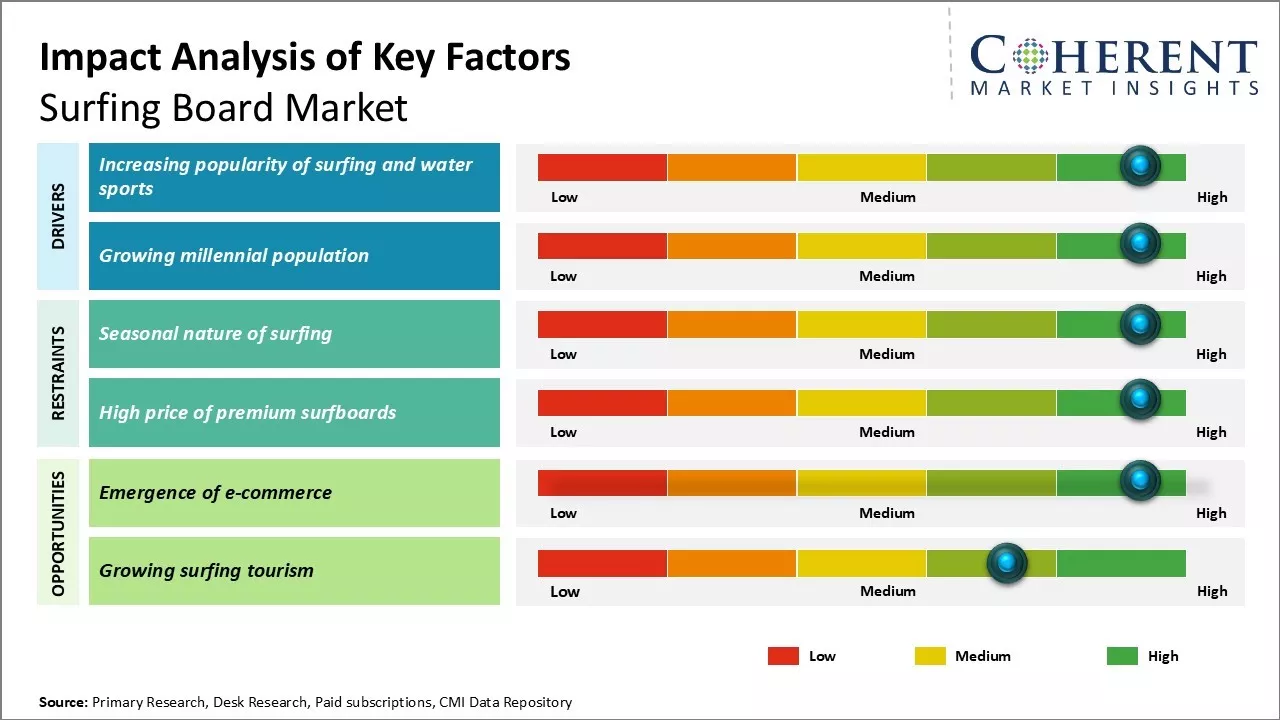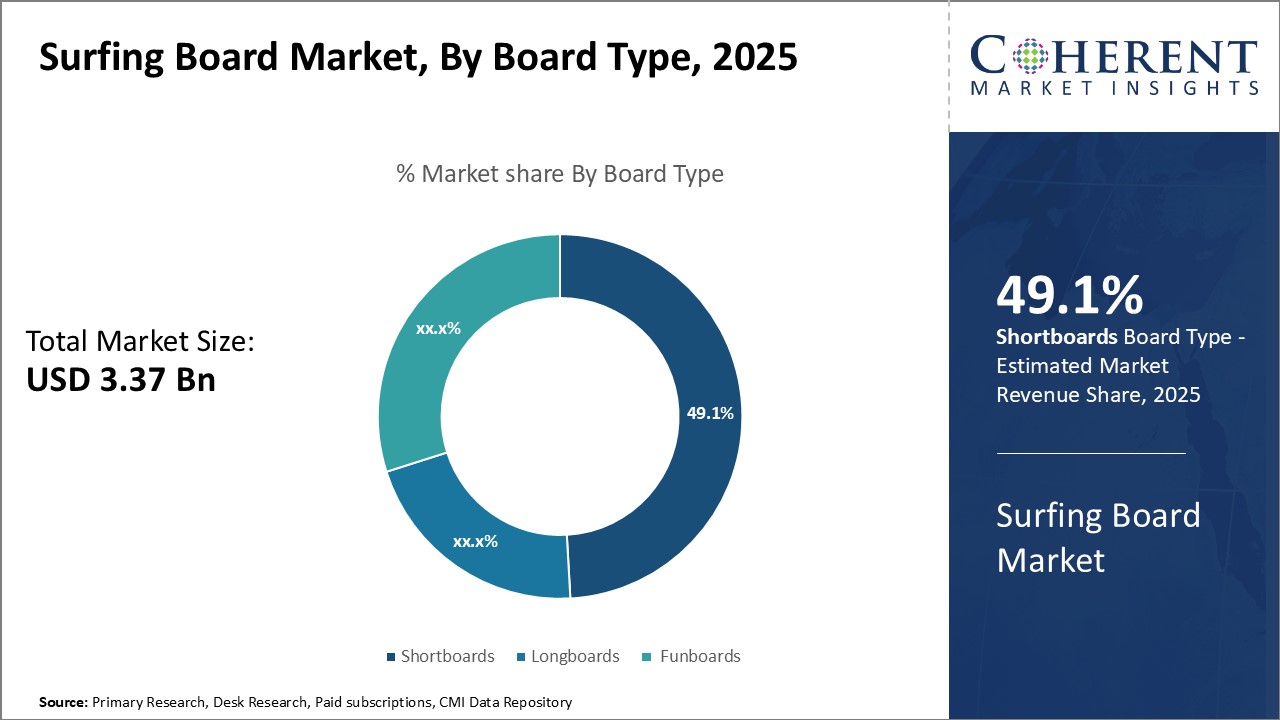Surfing Board Market Size and Trends
The surfing board market is estimated to be valued at USD 3.37 Billion in 2025 and is expected to reach USD 5.17 Billion by 2032, exhibiting a compound annual growth rate (CAGR) of 6.3% from 2025 to 2032.

Discover market dynamics shaping the industry: Download Free Sample
The surfing board market is expected to witness positive growth over the forecast period. Wide availability of surfing boards through offline and online distribution channels along with growing popularity among young populace as an adventure sport are likely to drive the demand. In addition, increasing health consciousness, rising disposable income, and growing number of surfing tournaments organized globally each year are expected to propel the surfing board industry expansion through 2032. However, the seasonal nature of the sport and premiumization of products might restrict the market growth to some extent during the forecast period.
Increasing popularity of surfing and water sports
As lifestyle sports are gaining more popularity, the interest in various water sports activities have seen a steady rise over the past few years. Surfing, in particular, has emerged as one of the most popular water sport attracting people from across all age groups and demographics. Once considered a niche extreme sport confined within beachside communities, surfing culture has now spilled over to mainstream appeal. Many factors have contributed to this increasing interest in surfing as a sport and lifestyle pursuit.
Rising health consciousness and growing preference for outdoor and adventure activities have been a major driver for this popularity surge. More people are eager to spend their free time engaged in physically and mentally stimulating pursuits rather than being glued to screens. Surfing provides an unmatched full-body workout involving balancing, paddling and wave-riding skills in a visually appealing natural ocean setting. Celebrity endorsement from athletes and pop culture figures have also elevated surfing's cool quotient and turned it into a desirable recreational activity. Improving accessibility through inexpensive board sport rentals and learn-to-surf tutorials have further lowered the barriers of entry.
Digital content explosion on YouTube and Instagram flooded by stunning surfing videos and photos from picturesque locales around the world have stoked wanderlust among many. This combined with rising disposable incomes have spurred more people to include surfing and beach vacations in their travel itineraries. Growing surf tourism especially in top surf destinations across Asia-Pacific, Americas and Africa indicate the strong appeal of the sport. Communities have also responded to this enthusiasm by establishing more surf schools and clubs along with hosting local and international surfing competitions.
Overall, the confluence of these demand drivers has expanded the fanbase of surfing well beyond its traditional pockets. This bodes well for the surfboard market as greater participation translates to renew spending on equipment upgrades or purchases. Along with occasional users, more committed surfers also refresh their quiver more frequently driving repeat sales. As this uptick gains further momentum, the surfboard industry can expect continuing revenues from both new and existing customers.
Market Concentration and Competitive Landscape

Get actionable strategies to beat competition: Download Free Sample
Growing millennial population
A concerning trend for many consumer industries have been the changing spending behaviors of the huge millennial demographic cohort. Often characterized as frugal, experience-focused digital natives with delayed life milestones, millennials posed challenges to traditional business models. However, the surf industry seems uniquely poised to capture the passions of this generation born 1981-1996 which currently makes up over a quarter of the U.S. population.
Comprising of avid travelers with strong environmental leaning, millennials have displayed a flair for outdoor and eco-friendly brands that cultivate feel-good associations. Surfing naturally fits this values-driven lifestyle followed by many in this generation. Furthermore, growing up on a diet of internet and social media, surf brands today skillfully leverage digital touchpoints and influencer marketing to sharply target millennials. Their messaging focuses on surfing's counterculture heritage, connection with nature and photo-worthy experiences over lavish displays of material acquisition that may not resonate as much.
As they approach their prime spending years, millennials also exhibit high levels of participation in niche sporting activities like surfing. This likely stems from their upbringing during the fitness boom period when individual pursuits became widely accessible through mainstream competitions, reality shows and affordable introductory programmes. Early exposure to water sports may have also seeded a passion for wave-riding as young adults. Currently pursuing educations or starting careers, many millennials are allocating expendable incomes to pursue their active hobbies through equipment purchases, memberships and travel to surf destinations.
Crucially, unlike previous transient surfers, millennials display stronger loyalty to surf lifestyle brands that meet their demands for environmental and social consciousness.
Key Takeaways from Analyst:
The surfing board market is expected to grow steadily driven by increasing popularity of surfing as a recreational and competitive sport. Rising consumer affinity towards water sports and outdoor activities will also support market expansion. Additionally, the proliferation of surf schools and programs targeted at beginners and amateur surfers will help boost market revenues. Adoption of eco-friendly surfboards made from sustainable materials like bamboo presents an opportunity for manufacturers to align with environment consciousness trends and appeal to ethically driven consumers.
However, high dependency on weather and ocean conditions remains a major restraint to the market growth. Seasonal changes and lack of annual surfable waves in certain geographies hamper constant demand and sales generation. Substantial R&D and manufacturing costs also limit the entry of new players. Geographically, North America and Australia are likely to continue dominating global sales owing to surfer culture and widespread beaches. Beyond these regions, newer areas like parts of Africa and Southeast Asia offer prospect for future market gains.
On the product front, shortboards and longboards will see steady demand however growth in the funboards, hybrids and inflatables segment is expected to contribute significantly to revenues. This shift can be attributed to varying interests of new-age surfers and their willingness to experiment with diverse surfing platforms.
Market Challenges: Seasonal nature of surfing
One of the key challenges faced by the surfing board market is its highly seasonal nature. Surfing is an activity that is dependent on weather conditions and availability of waves. Most surfing activities are concentrated in certain months of the year when weather conditions are ideal for generating good waves. The demand for surfing boards is thus highly seasonal with peak sales seen only for a few months. This leaves manufacturers and retailers with unsold inventory for most part of the year. They have to plan production and procurement well in advance based on forecasts of seasonal demand peaks. However, demand can vary significantly year on year depending on actual weather patterns. This leads to risks of over or under production. Storing unsold inventory also leads to warehousing costs. The seasonal nature of surfing thus poses supply chain challenges for players in surfing board market to adjust according to volatile demand patterns.
Market Opportunities: Emergence of E-commerce
The growth of e-commerce platforms is opening new opportunities for the surfing board market to address its seasonal demand challenges. Online retail channels are helping to reduce the impact of seasonality by enabling sales throughout the year instead of only in the peak seasons. Surfers and enthusiasts can now purchase surfing gear online according to their needs without having to wait for the local stores to stock up. Manufacturers and retailers are also able to reach newer customer segments in non-surfing destinations. The emergence of robust e-commerce platforms and rising internet penetration globally is enabling the surfing board market players to market and sell their products online beyond the peak season locations. This is helping them better utilize production capacities as well as manage inventory more efficiently with demand spread over multiple seasons instead of clustered in only a few months. The e-commerce channels are thus emerging as an opportunity for the seasonal surfing board market to overcome its traditional challenges.

Discover high revenue pocket segments and roadmap to it: Download Free Sample
Insights by board type: Performance and Maneuverability
In terms of board type, the shortboards segment is expected to contribute 49.1% share of the market in 2025, owing to its performance advantages over other board types. Shortboards are generally between 5 to 7 feet long and have a narrower design that allows for easier spin maneuvers and sharper turns. The compact size of shortboards make them highly responsive to rider input, enabling experienced surfers to execute precision performances like cutbacks, snaps, and floaters with greater control. Their maneuverability has made shortboards the preferred board type for surf competitions as well as big wave riding where quick reaction is critical. While longboards and funboards offer more stability for beginners, advanced surfers flock to shortboards to take their skills to the next level and tackle bigger waves through improved agility and speed. The performance benefits of shortboards, along with their popularity among pro surfers, have cemented its position as the largest segment in the By Board Type category.
Insights by material: Durability and Customizability
In terms of material, the polyurethane segment is expected to contribute 54.9% share of the market in 2025, owing to its longevity and customizability. Polyurethane boards last considerably longer than fiberglass or epoxy boards as the material is highly resistant to impact damage from rocks on the ocean floor or bumps against other surfers. Its dent-resistant property helps polyurethane boards maintain their shape and performance longer without requiring repairs as often as fiberglass boards. Additionally, polyurethane allows for detailed graphic application and coloring, enabling board shapers to customize designs according to customer preferences. Surfers are drawn to the personalization options and extended lifespan provided by polyurethane boards, making it the most popular material type among both pros and recreational surfers alike. The combination of durability and ability to reflect individual expression have made polyurethane the dominant segment in the material category.
Insights by end user: Recreational Appeal
In terms of end user, the recreational surfers segment is expected to contribute 55.2% share of the market in 2025, owing to surfing's appeal as a relaxing outdoor activity. Unlike professional surfers who focus on competition, most recreational surfers participate to relieve stress, enjoy coastal scenery, and spend time with friends in a laidback environment. They are attracted to the refreshing physical exercise and mental refreshment provided by surfing sessions, even if wave-riding skills are limited. With busy career and family lives, recreational surfers also appreciate surfing's flexibility as an activity that can be easily fit into daytime or evening hours depending on tidal schedules and commitments. Though beginner and pro segments are growing, recreational surfers still make up the bulk of the surfing population worldwide due to the accessible, stress-relieving nature of the sport. Their large numbers and consistent participation has cemented recreational surfing as the biggest end user segment in the market.
Regional Insights

Need a Different Region or Segment? Download Free Sample
North America has been the dominant region in the global surfing board market for several years. The region is expected to hold 37.2% share of the market in 2025. The U.S, in particular California and Hawaii, have strongly influenced surfing culture and board design since the sport first originated in the mid-20th century. Several of the world's largest surfing board manufacturers are based in Southern California and benefit from proximity to popular surf breaks that allow for product testing and feedback directly from pro surfers. This has supported innovative board designs tailored for different wave conditions and rider skill levels.
Furthermore, the widespread popularity of surfing as a mainstream recreational activity in the U.S. drives high demand for boards. Coastal populations have easy access to surf spots and surf tourism is a large industry in California and Hawaii specifically. Retailers located near surf beaches enjoy consistent business throughout the year. Larger consumer bases translate to stronger sales volumes for manufacturers. The competitive manufacturing environment in North America also contributes to quality board production at competitive prices for the mass market.
The Asia Pacific region is the fastest growing market for surfing boards, driven by the increasing popularity of water sports and the rising disposable incomes of the burgeoning middle-class population. Countries like Australia, Indonesia, and Japan are at the forefront of this growth, with a thriving surf culture and a growing number of surfing enthusiasts. Australia, in particular, is a major contributor to the Asia Pacific surfing board market, owing to the country's long coastline, favorable climatic conditions, and well-established surf tourism industry. The rising number of domestic and international tourists visiting Australia's world-renowned surf spots has fueled the demand for high-quality surfing boards, propelling the regional market growth.
Market Report Scope
Surfing Board Market Report Coverage
| Report Coverage | Details | ||
|---|---|---|---|
| Base Year: | 2024 | Market Size in 2025: | USD 3.37 Bn |
| Historical Data for: | 2020 To 2024 | Forecast Period: | 2025 To 2032 |
| Forecast Period 2025 to 2032 CAGR: | 6.3% | 2032 Value Projection: | USD 5.17 Bn |
| Geographies covered: |
|
||
| Segments covered: |
|
||
| Companies covered: |
Kallialay Original Series, Blu Surfboards, Nico Erni, Coral Surfboards, Alai Surfboards, Kove Kraft, ThunderMonkey, NSP, Haydenshapes, Firewire, FCS, Prolite, Yolo Kayaks, Zinka Sunscreen, Showa Denko K.K., BIC Sport, Surftech, and Channel Islands Surfboards |
||
| Growth Drivers: |
|
||
| Restraints & Challenges: |
|
||
Uncover macros and micros vetted on 75+ parameters: Get instant access to report
Surfing Board Industry News
- In July 2024, Firewire Surfboards announced the global launch of its latest innovation, the MACHADOCADO. This new surfboard model, designed in collaboration with renowned surfer, Rob Machado, combines cutting-edge technology with eco-friendly materials to enhance performance on the waves. The MACHADOCADO aims to provide surfers of all skill levels with an exceptional riding experience, reflecting Firewire's commitment to sustainability and innovation in surfboard design.
- In July 2024, John Florence and Jon Pyzel unveiled their latest board model, the Power Tiger. This new surfboard is designed to optimize performance in a variety of wave conditions, reflecting the innovative spirit and expertise of both Florence, a two-time world champion surfer, and Pyzel, a renowned shaper. The Power Tiger incorporates advanced materials and design features aimed at enhancing speed, maneuverability, and control, making it an ideal choice for surfers looking to elevate their game. With this collaboration, Florence and Pyzel continue to set new standards in surfboard design, catering to both competitive and recreational surfers alike.
*Definition: A surfing board is a narrow plank-like object that allows surfers to glide across the surface of ocean waves and ride them towards the shore. Modern surfing boards are optimized for various surfing conditions and range from shortboards for big waves to longboards for mellow surf. They come in different shapes, sizes, materials, and colors to suit different rider styles, abilities, and water environments.
Market Segmentation
- By Board Type Insights (Revenue, USD Bn, 2020 - 2032)
-
- Shortboards
- Longboards
- Funboards
- By Material Insights (Revenue, USD Bn, 2020 - 2032)
- Polyurethane
- Fiberglass
- EPS/Epoxy
- By End-user Insights (Revenue, USD Bn, 2020 - 2032)
- Recreational Surfers
- Professional Surfers
- Beginner Surfers
- By Regional Insights (Revenue, USD Bn, 2020 - 2032)
- North America
- U.S.
- Canada
- Latin America
- Brazil
- Argentina
- Mexico
- Rest of Latin America
- Europe
- Germany
- U.K.
- Spain
- France
- Italy
- Russia
- Rest of Europe
- Asia Pacific
- China
- India
- Japan
- Australia
- South Korea
- ASEAN
- Rest of Asia Pacific
- Middle East
- GCC Countries
- Israel
- Rest of Middle East
- Africa
- South Africa
- North Africa
- Central Africa
- North America
- Key Players Insights
- Kallialay Original Series
- Blu Surfboards
- Nico Erni
- Coral Surfboards
- Alai Surfboards
- Kove Kraft
- ThunderMonkey
- NSP
- Haydenshapes
- Firewire
- FCS
- Prolite
- Yolo Kayaks
- Zinka Sunscreen
- Showa Denko K.K.
- BIC Sport
- Surftech
- Channel Islands Surfboards
Share
Share
About Author
Yash Doshi is a Senior Management Consultant. He has 12+ years of experience in conducting research and handling consulting projects across verticals in APAC, EMEA, and the Americas.
He brings strong acumen in helping chemical companies navigate complex challenges and identify growth opportunities. He has deep expertise across the chemicals value chain, including commodity, specialty and fine chemicals, plastics and polymers, and petrochemicals. Yash is a sought-after speaker at industry conferences and contributes to various publications on topics related commodity, specialty and fine chemicals, plastics and polymers, and petrochemicals.
Missing comfort of reading report in your local language? Find your preferred language :
Transform your Strategy with Exclusive Trending Reports :
Frequently Asked Questions
EXISTING CLIENTELE
Joining thousands of companies around the world committed to making the Excellent Business Solutions.
View All Our Clients
